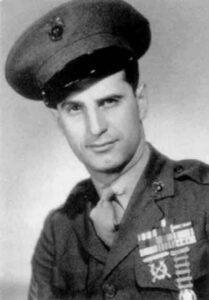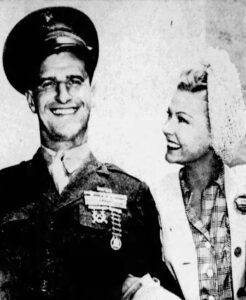
Exactly 108 years ago, on December 30, 1915, the First World War was raging, and the forces of evil were already trying to exterminate the Armenian population. But thousands of miles away, in Chicago, Illinois, the Maghakian family was celebrating the birth of a beautiful baby named Victor. This little boy was the first child of Dickran and Alice Maghakian, two Armenian refugees who were forced to leave their beloved land. Victor grew into a kindhearted, friendly and cheerful teenager who always had a smile on his face. He was the oldest of four brothers and three sisters. As his father worked hard at the steel mill, Victor took on much of the responsibility of raising his younger siblings. In 1930, the Maghakian family moved from Chicago to San Diego, California.
The defining moment that changed the course of Victor’s life happened in 1936. On an ordinary sunny day, Victor made the decision to join the U.S. Navy. He felt it was his duty to serve his country and couldn’t wait to go overseas. Later that day, he headed towards the U.S. Navy recruiting office, but as he walked past a movie theater, he decided to buy a ticket to watch Pride of the Marines starring Charles Bickford. The movie was a revelation for Victor, who immediately headed towards the Marine Corps recruiting office instead. Shortly after, the Maghakian family moved to Fresno, California, and lived next to William Saroyan, the legendary Armenian American novelist who was awarded the Pulitzer Prize for Drama in 1940 and won the Academy Award for Best Story for the movie The Human Comedy. After saying goodbye to his loved ones, Victor was sent to Asia and was stationed in the Philippines and China for four years. He fulfilled his duties admirably and was frequently sent to different countries. Victor’s extensive understanding and knowledge of foreign bases and societies led him to be nicknamed “Transport” by his fellow Marines.

In early 1942, Victor was among the 900 Marines (out of 15,000) selected to join the 2nd Marine Raider Battalion. Only the best Marines could become members of this elite Battalion. By August, the time had come to confront Japanese forces on Makin Island in the Pacific Ocean. During the raid, Platoon Sergeant Victor Maghakian demonstrated remarkable courage and outstanding determination, but while leading his men, he was struck by enemy fire. His forearm was injured so badly that he struggled to remain conscious. Ignoring pain and fear, Victor wrapped up his open wound and launched a successful solo attack against the Japanese position. Shortly after, Victor received medical first aid and was ordered to return to the rear, but he refused to do so and kept fighting with his brothers-in-arms. For his bravery and leadership on Makin Island, Victor was awarded the Navy Cross, which is the second highest military decoration for valor and extraordinary heroism in combat. The American war movie Gung Ho! was based on the Makin Island raid led by the 2nd Marine Raider Battalion. Victor’s role was played by famed actor Sam Levene.
A few weeks later, during the deadly Battle of Guadalcanal, Victor and his comrades were ambushed and pinned down by heavy fire. In order to save his men, Victor stood up and revealed his exact position, so that the Japanese soldiers would come out of their hiding spots. Victor’s wrist was struck by enemy fire, but thanks to his incredible act of courage, his men were able to kill all the Japanese soldiers. After the Battle of Guadalcanal, Victor spent two months in a U.S. Navy hospital in Oakland, California. During that time, he married the love of his life, Vera Karaoglanian. They couldn’t wait to spend the rest of their lives together, but Victor had to end this never-ending war, so he returned to combat duties. In January 1944, he volunteered to participate at the Battle of Kwajalein, where he killed several Japanese soldiers and captured two. A month later, Victor was fighting on the Eniwetok Atoll, where he saved the life of Private First Class Lee Marvin, who later became a famous actor.
Throughout the entire war, Victor led his men through some of the bloodiest fighting in seven South Pacific campaigns. Day after day, week after week, month after month, he fought in hell for a heavenly cause.

Following the war, Victor returned to Fresno and later moved to Las Vegas, where he was employed by a hotel and casino from 1954 to 1974. This true Armenian American hero died of cancer on August 17, 1977, at the age of 61, and he is now resting in peace at the Ararat Cemetery in Fresno. Looking back on her brother’s life, Victor’s sister stated: “He was a quiet and dedicated man and was always very calm, except for war. He was such a giving man.”
At this moment in time, when the forces of evil are still trying to exterminate the Armenian population, the extraordinary story of Victor Maghakian must encourage all Armenians to never give up, never give in and never lose hope. Outnumbered by ruthless enemies, and relentlessly attacked, Victor always prevailed, and so will Armenia.



Fantastic article. Thank you John. Rest in peace Victor.
Hand salute!
Mike Jerikian
United States Naval Chief (Retired)